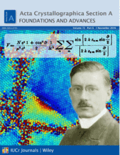
Acta Crystallographica A-Foundation and Advances
Scope & Guideline
Pioneering discoveries in crystallography and beyond.
Introduction
Aims and Scopes
- Crystallographic Theory and Methodology:
The journal publishes research related to the development and refinement of crystallographic methods, including structure determination, data processing, and the application of advanced techniques such as X-ray and neutron diffraction. - Materials Science and Engineering:
Research focusing on the structural properties of various materials, including metals, ceramics, and polymers, is a core area of interest. Studies often include the relationship between structure and properties in materials science. - Biomolecular Crystallography:
A significant portion of the journal's content is dedicated to the crystallography of biological macromolecules, including proteins and nucleic acids, and the implications for drug design and biochemistry. - Computational Crystallography:
The integration of computational methods with experimental crystallography is highlighted, including machine learning applications, molecular dynamics simulations, and quantum mechanical calculations. - Symmetry and Group Theory in Crystallography:
Research that explores the role of symmetry and group theory in understanding crystal structures and their properties is prominently featured, aiding in the classification and analysis of crystalline materials.
Trending and Emerging
- Machine Learning and AI in Crystallography:
There is a significant increase in research applying machine learning and artificial intelligence to crystallography, particularly in data analysis, structure prediction, and automated workflows. - In Situ and Operando Studies:
Emerging techniques that allow for in situ and operando studies of materials are gaining traction. This includes real-time monitoring of structural changes during chemical reactions or physical transformations. - Sustainability and Green Chemistry:
Research focusing on sustainable practices in crystallography, including green solvents and eco-friendly synthesis methods, is becoming more prevalent, reflecting a broader trend towards sustainability in scientific research. - Hybrid and Multi-Method Approaches:
Papers that utilize hybrid methods combining different techniques (e.g., X-ray diffraction, SAXS, NMR) to gain comprehensive insights into material properties are increasingly common, indicating a trend towards more integrated research methodologies. - Exploration of Novel Materials:
There is a growing interest in the crystallography of novel materials, including metal-organic frameworks (MOFs) and perovskites, particularly in relation to their applications in energy storage, catalysis, and electronics.
Declining or Waning
- Traditional Inorganic Crystallography:
There has been a noticeable reduction in publications focused solely on traditional inorganic crystallography, particularly studies that do not incorporate modern computational methods or multidisciplinary approaches. - Static Structure Analysis:
Research emphasizing static structural analysis of crystals is becoming less frequent, as there is a growing preference for studies that consider dynamic behavior and structural changes under various conditions. - Classical Crystal Growth Techniques:
Papers dedicated to classical techniques of crystal growth are declining, with a shift towards more innovative and automated methods that integrate real-time monitoring and advanced synthesis techniques.
Similar Journals
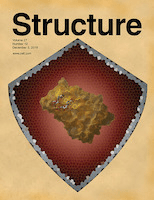
STRUCTURE
Unveiling the intricate dance of proteins and structures.STRUCTURE is a premier academic journal published by CELL PRESS, dedicated to advancing the field of structural biology and molecular biology since its inception in 1993. With an impressive reputation, it is recognized as a Q1 journal in both Molecular Biology and Structural Biology categories, reflecting its high impact within the academic community. The journal holds a significant position in Scopus rankings, placing 10th among 49 in Structural Biology and 100th among 410 in Molecular Biology, marking it as a key resource with a strong influence on ongoing research. Researchers and professionals alike will find STRUCTURE an invaluable platform for disseminating cutting-edge findings related to protein structure, dynamics, and interactions, fostering insights that can lead to groundbreaking applications in medicine and biotechnology. Although the journal follows a traditional subscription model, it continues to attract a diverse array of submissions, ensuring a vibrant exchange of knowledge in the ever-evolving landscape of structural and molecular biology. Access to its content can enhance the understanding of intricate biological mechanisms, making it essential reading for experts, students, and anyone passionate about the molecular underpinnings of life.
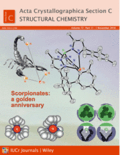
ACTA CRYSTALLOGRAPHICA SECTION C-STRUCTURAL CHEMISTRY
Unveiling Innovations in CrystallographyACTA CRYSTALLOGRAPHICA SECTION C-STRUCTURAL CHEMISTRY is a respected journal in the fields of condensed matter physics, inorganic chemistry, and materials chemistry, published by the International Union of Crystallography. With an extensive history dating back to its inception in the late 1980s, this journal serves as a significant platform for researchers to disseminate high-quality research on structural chemistry, focusing on the synthesis and characterization of crystalline materials. Despite currently holding a Q4 ranking across multiple academic categories, it remains an essential resource for those engaged in these scientific disciplines, facilitating dialogue and collaboration among experts. The journal's commitment to publishing innovative studies ensures that it continues to contribute to the advancement of knowledge in its field. Although it does not offer Open Access, the journal is dedicated to maintaining rigorous peer-review standards, making it a reliable source for scholars and practitioners alike. Located in the United States, ACTA CRYSTALLOGRAPHICA SECTION C is a pivotal part of the global crystallography community.

Crystallography Reviews
Catalyzing Discovery in Crystallography and Materials ScienceCrystallography Reviews is a premier academic journal published by Taylor & Francis Ltd, dedicated to advancing the field of crystallography and its applications across various scientific domains. With an ISSN of 0889-311X and an E-ISSN of 1476-3508, this journal has established itself as a vital resource for researchers and practitioners since its inception. It encompasses a broad scope, including insights into biochemistry, general chemistry, condensed matter physics, materials science, and structural biology, reflecting a multidisciplinary approach that is essential in today’s research environment. As indicated by its 2023 quartile rankings, it holds a distinguished position in the Q1 category for Condensed Matter Physics and Q2 in several other significant fields. Notably, it ranks #31 in the Scopus category for Structural Biology, underscoring its influence and relevance. Although it does not offer Open Access options, the journal maintains a strong commitment to quality and rigor in its publication process. For scholars and students striving for a competitive edge in crystallographic research, Crystallography Reviews serves as an indispensable tool for disseminating pivotal findings and fostering academic dialogue.
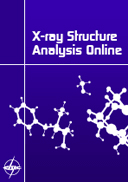
X-Ray Structure Analysis Online
Unlocking the Secrets of Material StructuresX-Ray Structure Analysis Online is a pivotal academic journal dedicated to the field of analytical and materials chemistry, published by the Japan Society for Analytical Chemistry. Established in 2009, this journal serves as a vital platform for researchers and professionals dedicated to advancing the understanding of X-ray structural analysis techniques and their applications. With ISSN 1883-3578, it operates under rigorous peer-review standards, promoting high-quality research contributions. While the journal is currently categorized in the Q4 quartile for both Analytical Chemistry and Materials Chemistry, its focus on cultivating a deeper understanding of material properties through X-ray analysis remains crucial for ongoing developments in these fields. By providing an accessible outlet for innovative studies, X-Ray Structure Analysis Online supports the academic community in overcoming the challenges of a rapidly evolving scientific landscape. It is particularly valuable for those engaged in material and analytical research, offering insights that contribute to both theoretical foundations and practical applications.

TRANSITION METAL CHEMISTRY
Illuminating Discoveries in Inorganic ChemistryTransition Metal Chemistry is a distinguished journal published by Springer, focusing on the latest advancements in the field of inorganic chemistry, materials science, and metals and alloys. With an impressive publication history dating back to 1975, this journal serves as an essential platform for researchers and professionals seeking to explore the complexities and innovations in transition metal chemistry. Transition Metal Chemistry holds a Q4 ranking in Inorganic Chemistry and positions itself in Q3 within both Materials Chemistry and Metals and Alloys categories, highlighting its evolving influence in these domains. With a Scopus ranking of #41 in Inorganic Chemistry and #56 in Materials Science, it provides readers with valuable insights into research trends and discoveries. Although it does not offer open access, its rigorous peer-review process ensures that only the most impactful and validated studies are published. By bridging theoretical concepts and practical applications, Transition Metal Chemistry plays a pivotal role in advancing scientific knowledge, attracting a diverse audience of researchers, students, and industry professionals committed to unraveling the complexities of transition metals.

PROTEINS-STRUCTURE FUNCTION AND BIOINFORMATICS
Advancing Knowledge in Biochemistry and BeyondPROTEINS - STRUCTURE FUNCTION AND BIOINFORMATICS, published by WILEY, is a leading journal in the fields of biochemistry, molecular biology, and structural biology, recognized for its significant contribution to protein research since its inception in 1986. With its impressive rankings in the Q1 category for Biochemistry and Q2 for both Molecular Biology and Structural Biology in 2023, the journal serves as an essential resource for researchers and professionals seeking to explore the intricate relationships between protein structures and their functions. The journal, based in the United States, operates without an Open Access model, ensuring a curated selection of high-quality peer-reviewed articles that drive innovation and collaboration in the scientific community. Engaging with the robust content of PROTEINS not only bolsters academic scholarship but also opens avenues for groundbreaking discoveries that are pivotal in the advancing field of bioinformatics.
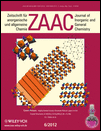
ZEITSCHRIFT FUR ANORGANISCHE UND ALLGEMEINE CHEMIE
Pioneering Research in Inorganic and General ChemistryZEITSCHRIFT FUR ANORGANISCHE UND ALLGEMEINE CHEMIE, published by WILEY-V C H VERLAG GMBH, is a pivotal journal in the field of inorganic chemistry, catering to the needs of researchers, professionals, and students seeking to advance their understanding of this dynamic discipline. With its historical roots dating back to 1892 and a commitment to high-quality research, this journal provides a platform for the dissemination of significant findings related to inorganic substances and their general chemistry. Although currently not an open-access journal, it holds a competitive position with an impact factor placing it in the Q3 quartile of the Inorganic Chemistry category, ranking #57 out of 79 in Scopus. Situated in Germany, this journal not only connects past and present research endeavors but also aims to foster innovation and collaboration within the inorganic chemistry community. Whether you are exploring fundamental concepts or groundbreaking applications, ZEITSCHRIFT FUR ANORGANISCHE UND ALLGEMEINE CHEMIE remains an invaluable resource for advancing chemical sciences.

Acta Crystallographica Section E-Crystallographic Communications
Pioneering open access in crystallography for global collaboration.Acta Crystallographica Section E-Crystallographic Communications is a premier academic journal dedicated to the field of crystallography, published by the International Union of Crystallography. With an Open Access model established since 2008, this journal fosters the rapid dissemination of significant research findings in crystallographic studies, offering researchers and professionals the ability to freely share and access critical data. The journal is recognized for its contribution to various interdisciplinary categories, achieving notable standings in the 2023 rankings, categorized in the Q3 quartile in Chemistry (miscellaneous) and Materials Science, and the Q4 quartile in Condensed Matter Physics. By bridging the gap between theoretical and practical aspects, Acta Crystallographica Section E serves as a vital resource for those looking to deepen their understanding of crystallographic phenomena and its applications in science and engineering. The journal maintains its commitment to quality and innovation in research, ensuring a vibrant platform for scholarly communication within the scientific community.

Results in Chemistry
Advancing the Frontiers of Chemical ResearchResults in Chemistry is a prominent journal published by Elsevier, dedicated to fostering innovation and disseminating cutting-edge research in the field of chemistry. With an ISSN of 2211-7156, this open-access journal has been committed to making scientific knowledge widely available since 2019, aligning with the global trend towards accessibility in research. Based in the Netherlands, it features interdisciplinary studies that span the breadth of general chemistry, contributing significantly to the academic dialogue within the scientific community. Despite currently holding a Q3 ranking in the miscellaneous category of chemistry and occupying the 228th position out of 408 in Scopus rankings, the journal is poised for growth, aiming to enhance its impact and visibility. Researchers, professionals, and students alike will find invaluable resources and insights within its pages, making Results in Chemistry an essential platform for those looking to stay abreast of advancements and trends in chemistry research up to the year 2024.
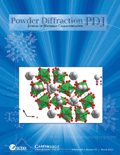
POWDER DIFFRACTION
Advancing the Frontiers of Powder Diffraction ResearchPOWDER DIFFRACTION, published by Cambridge University Press, is a pivotal journal focused on the evolving field of powder diffraction, which is crucial for researchers in condensed matter physics, materials science, and radiation studies. Established in 1986, this journal emphasizes the latest methodological advancements and applications in powder diffraction techniques, making it a comprehensive resource for professionals and students alike. With an ISSN of 0885-7156 and an E-ISSN of 1945-7413, it offers valuable insights into the characterizations of crystalline materials. Although currently not open access, the journal is highly regarded for maintaining rigorous peer review standards, reflecting in its rankings within the lower quartiles of relevant fields according to Scopus. Positioned within the United States and with distribution through Cambridge University Press, POWDER DIFFRACTION aims to foster innovation and knowledge exchange among the global scientific community, thereby solidifying its role as an essential platform for disseminating research findings from 1986 through to 2024 and beyond.